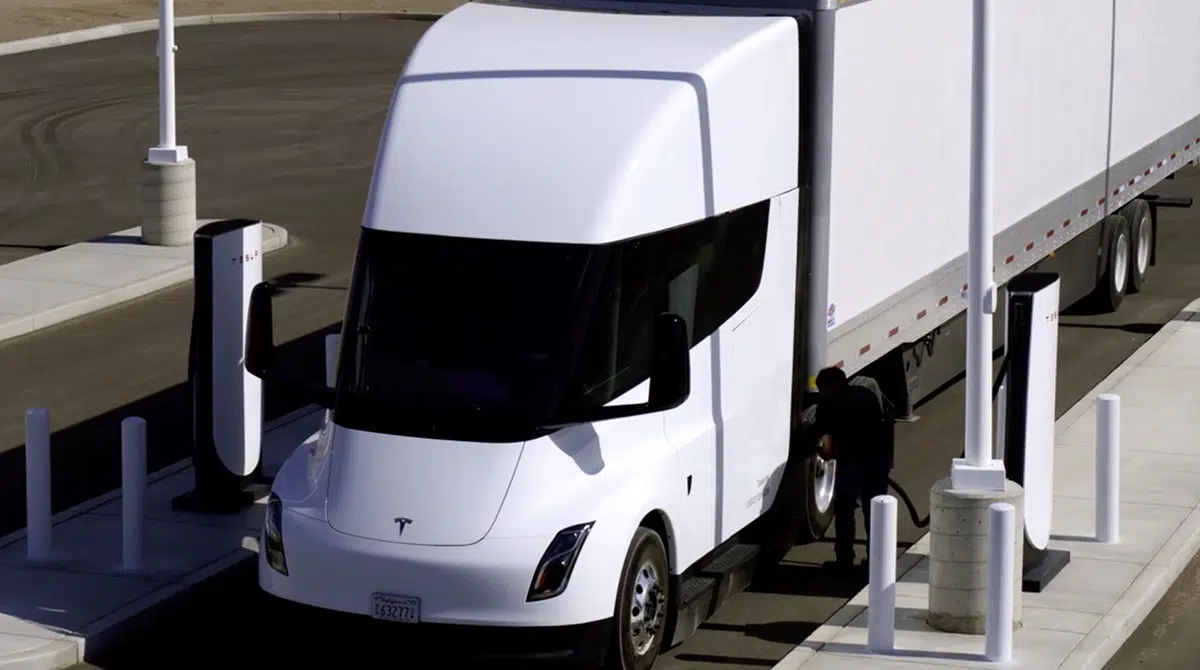With its innovative and effective passenger cars, Tesla has completely changed the world of electric mobility. Elon Musk, the co-founder of Tesla and CEO, stated plans to use the Tesla Semi electric vehicle to enter the commercial transportation sector in November 2017. After numerous setbacks and delays, Tesla ultimately began shipping the Tesla Semi Trucks to customers in the United States on December 1, 2022.
The Semi is not just any truck; it is a zero-emissions freight-hauling cargo vehicle that outperforms conventional oil guzzlers in every respect, including performance, range, economy, and operational expenses. Here is everything you need to know about Tesla Semi Truck.

Read Also: Things You Need To Know About 2023 Toyota Corolla
Tesla Semi Design
The Tesla Semi has a unique cab design that is likely the cleanest we have ever seen on a truck. It seems to be something from the future. Up front, a sizable glass area wraps around and slopes into the frunk. Because of its size, the glass area’s panels reach the doors. For improved aerodynamics, Tesla removed the door mirrors from the Semi. Instead, a feed is sent to the interior screens using cameras mounted at the very back.
Massive grilles are typically found on diesel vehicles to enhance airflow to large engines. Being an electric vehicle, the Tesla Semi has a blanked-off nose and a small air intake on its chin to cool the battery, which is located between the front and back axles. It has a 64-tractor arrangement with one axle up front and two axles at the back. The trailer bed and tow hitch are located at the back.
Specifications
The Day Cab on the Tesla Semi truck often enables a shorter and lighter body than a Sleeper Cab, resulting in lower energy usage. The Semi has a tri-motor powertrain that was introduced by Tesla. Later on, a quad-motor powertrain option is likely to be offered.
According to reports, the Semi’s under-the-cabin floor battery pack has an energy storage capacity of 850–1,000 kWh, sufficient to run ten Tesla Model X vehicles! In general, Tesla doesn’t reveal the battery pack capacity of its electric vehicles, and the Semi is no exception.
1,000-volt electrical system
For medium and smaller models like the Model 3, Model Y, and Tesla RoboTaxi, Tesla believes upgrading from a 400-volt to an 800-volt design would be costly. Nevertheless, the larger applications, such as the Cyber track and Semi, benefit from the greater system voltage, according to Baglino, who commented on April 20, 2022, during the company’s Q1 2022 earnings conference call.
Tesla Mega Charger

The enormous battery pack of the Tesla Semi necessitates longer charging times and faster charging rates. Megachargers, a Tesla invention, is a solution. As stated in its Impact Report 2020, the company is developing a network of Megachargers at trucking rest stations across the U.S. and Europe to make long-distance trips for truckers affordable.
The Semi supports charging at 1 megawatt, which is insane compared to the requirements for charging electric vehicles today! It only takes 30 minutes to charge on direct current at a Tesla Megacharger to 70% SoC, which is just enough time for the driver to take a little stop and recharge.
Performance & Capabilities
The Model S and Model X tri-motor powertrains from Tesla are used in the Semi. A Highway Drive Unit (efficiency motor) is put on one axle, and two Acceleration Drive Units (performance motors) are mounted on the other axle to make up the powertrain.
Maximum efficiency is guaranteed by the Highway Drive Unit’s continuous engagement and the Acceleration Drive Units’ selective engagement. Regarding efficiency, the tri-motor Semi uses under 2 kWh per mile. At 82,000 lbs, that is when it is completely loaded.
A fully loaded, three-motor Semi with an 82,000 lb. gross combined weight accelerates from 0 to 60 mph in 20 seconds. Highway speeds are possible up a 5% gradient. Tesla displayed a video of a fully-loaded tri-motor Semi (82,000 lbs.) handily outperforming a normal semi on the Donner Pass at a 6% inclination during the Semi delivery event.
500 miles of range
The range would be the primary consideration for truckers. Tesla has taken a thorough approach to range concerns. The Semi comes in two different models, one with a 300-mile range and the other with a 500-mile range. The 500-mile Semi is being shipped by Tesla first.
4680 Cells
It was widely believed that at least one version of the Tesla Semi would use 4680 cells. Musk has acknowledged that Tesla doesn’t employ 4680 cells in the Semi, though. The 4680 designation refers to a cell approximately 46 mm in diameter and 80 mm in length.
Interior & Features

Its interior is unique. According to Tesla, the driver’s seat is positioned in the middle of the vehicle, improving the view out the window. There is a red seatbelt on it. Two more foldable seats are located behind the driver’s seat. The extreme ends of the dashboard each have a sizable touchscreen. Expect these two screens to have truck-specific features that highlight trailer statistics and more as Tesla’s excellent user interface and the standard connectivity package available in its road cars.
A comprehensive list of remotely operated capabilities is available thanks to the Tesla Mobile application. Owners get remote access to Dispatch communication, location tracking, and diagnostics. Another function is predictive maintenance, which examines the truck’s condition and notifies the owner when maintenance is required.
Safety
Safety is another area where the Tesla Semi makes significant progress. The company’s ‘Enhanced Autopilot‘ set of functions was planned to become standard on the Tesla Semi. Automated emergency braking, forward collision warning, and automatic lane-keeping assistance are among various safety features. The Tesla Semi maintains lane position, slows down and gradually stops, and automatically calls an emergency number if it detects no driver input.
In Conclusion
Compared to conventional semi-trailer vehicles already on the market, including those converted from diesel to electric, The Tesla Semi truck is a revolutionary semi-truck that might make trucking simpler, more comfortable, and safer. It should also be significantly less expensive to operate and maintain.
FAQs
The price of the Semi quad-motor is expected to be USD 150,000 for the 300-mile variant and USD 180,000 for the 500-mile variant.





















Leave a Reply